How Diamond Tools Work
-
Posted by
 Alexander Schneider
Alexander Schneider
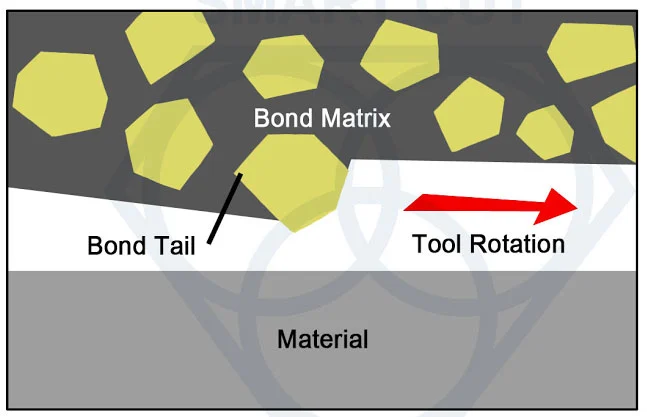
Table of Contents
ToggleDiamond & CBN Tools represent the highest engineering of cutting and grinding technology. These tools use their unparalleled hardness and durability of diamonds to perform tasks beyond the capabilities of conventional tools.

Essential across various industries, from advanced manufacturing to stone fabrication, diamond tools excel in processing the hardest and most challenging materials. They are capable of working with materials that have a hardness of 40 on the Rockwell scale and above, efficiently machining materials that are often challenging or even unmanageable for traditional abrasives, carbide, and high-speed steel tools.
CBN tools utilize cubic boron nitride, a synthetic material almost as hard as diamond, designed for machining ferrous materials. CBN tools are highly effective in high-speed cutting and heavy-duty grinding due to their excellent thermal stability and chemical inertness with ferrous materials. CBN tools are used primarily for machining ferrous metals.
Key Features of Diamond & CBN Tools:
-
 Exceptional Hardness: Diamond & CBN are the hardest known natural material, allowing diamond tools to cut and grind the toughest materials with ease.
Exceptional Hardness: Diamond & CBN are the hardest known natural material, allowing diamond tools to cut and grind the toughest materials with ease.
-
 Superior Wear Resistance: Diamond & CBN tools have a long lifespan due to their resistance to wear, maintaining cutting efficiency over extended use.
Superior Wear Resistance: Diamond & CBN tools have a long lifespan due to their resistance to wear, maintaining cutting efficiency over extended use.
-
 High Thermal Conductivity: Diamond & CBN effectively dissipate heat, reducing the risk of thermal damage to both the tool and material.
High Thermal Conductivity: Diamond & CBN effectively dissipate heat, reducing the risk of thermal damage to both the tool and material.
At the core of diamond & cbn tools is the unique integration of diamond or cbn particles within a specialized bond matrix. This matrix can be composed of several types, including sintered (metal bond), resin bond, hybrid bond, electroplated bond, braised bond and vitrified bond.
The bond matrix plays a crucial role in securely holding the diamond or cbn crystals, which are selected and mixed to form a durable and effective cutting medium.
For instance, sintered (metal bond) tools utilize specific metal alloys such as iron, cobalt, nickel, and bronze, combined in various proportions with over 200 other components. Resin bond tools incorporate phenolic resin and various ceramic fillers, while vitrified bond tools use a ceramic bond matrix.
The diamond tools have exposed diamond particles, each possessing a small cutting edge. These exposed edges are essential for the tool's cutting efficiency, as they interact directly with the material being processed.

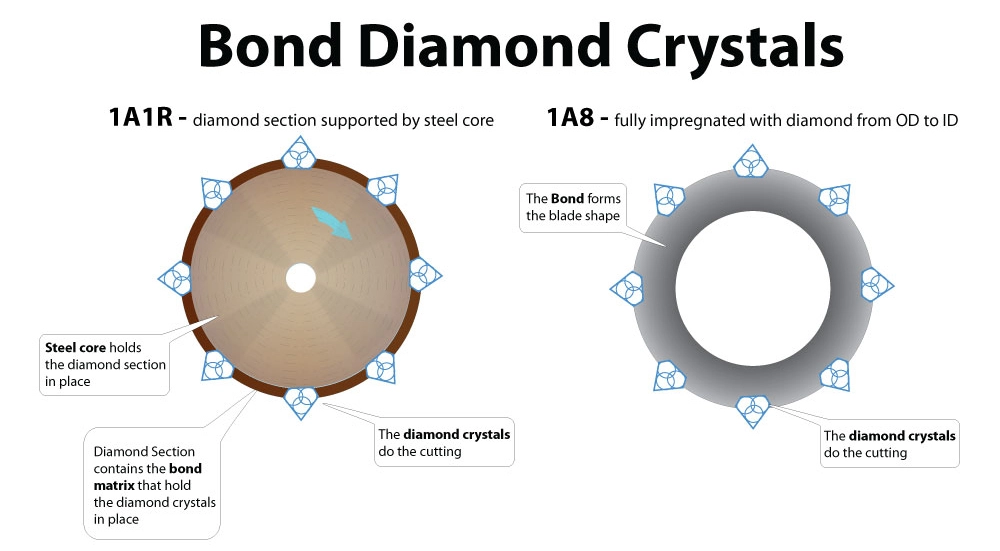
The tools are meticulously manufactured by embedding the diamonds within the bond matrix, ensuring that each diamond is held securely yet positioned to allow effective cutting or grinding.
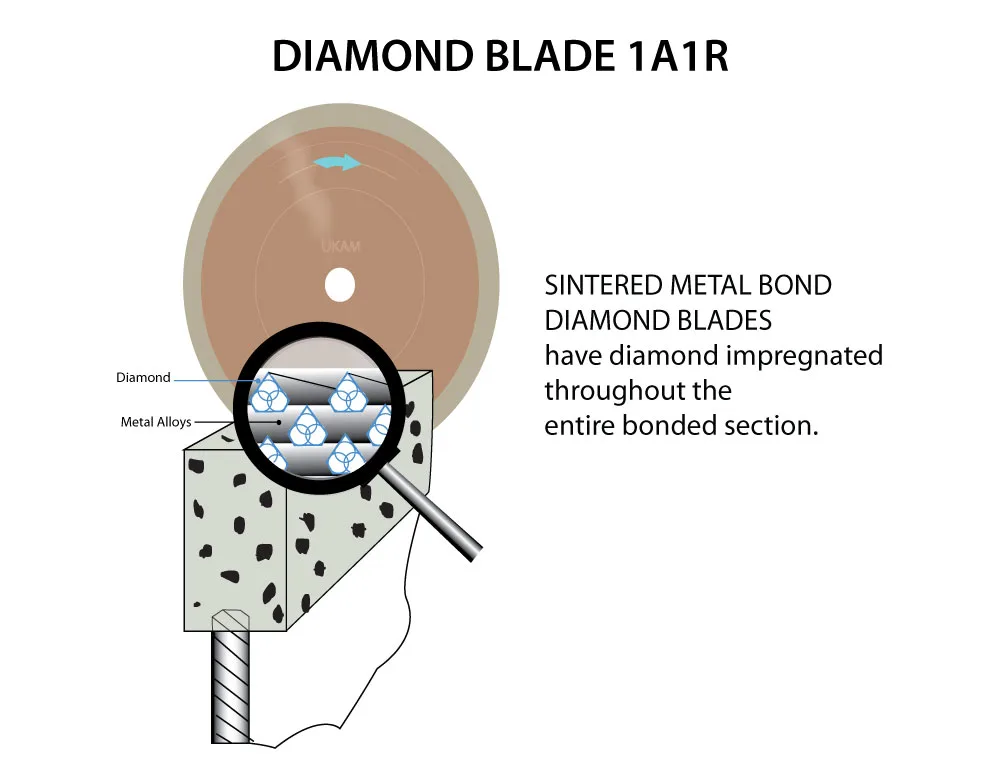
As diamond tools engage with materials, they utilize a combination of cutting, grinding, abrasion, and chipping mechanisms to achieve precise and efficient material removal.
The operational efficiency of diamond tools is maintained through a continuous cutting cycle, where the bond matrix steadily erodes to expose new diamond particles, ensuring consistent cutting performance. This cycle is influenced by various factors, including the material's hardness, the tool's rotational speed, and the environmental conditions, such as temperature and the presence of coolants or lubricants.
In this comprehensive article, we will cover all of the processes of how diamond & cbn tools work. We will explore the stages of initial contact, the role of exposed diamond action, the importance of bond matrix wear, and the continuous cutting cycle that sustains tool efficiency. Additionally, we will examine the critical mechanisms of cutting, grinding, abrasion, chipping, and debris removal, providing a thorough understanding of how these tools achieve their remarkable performance.
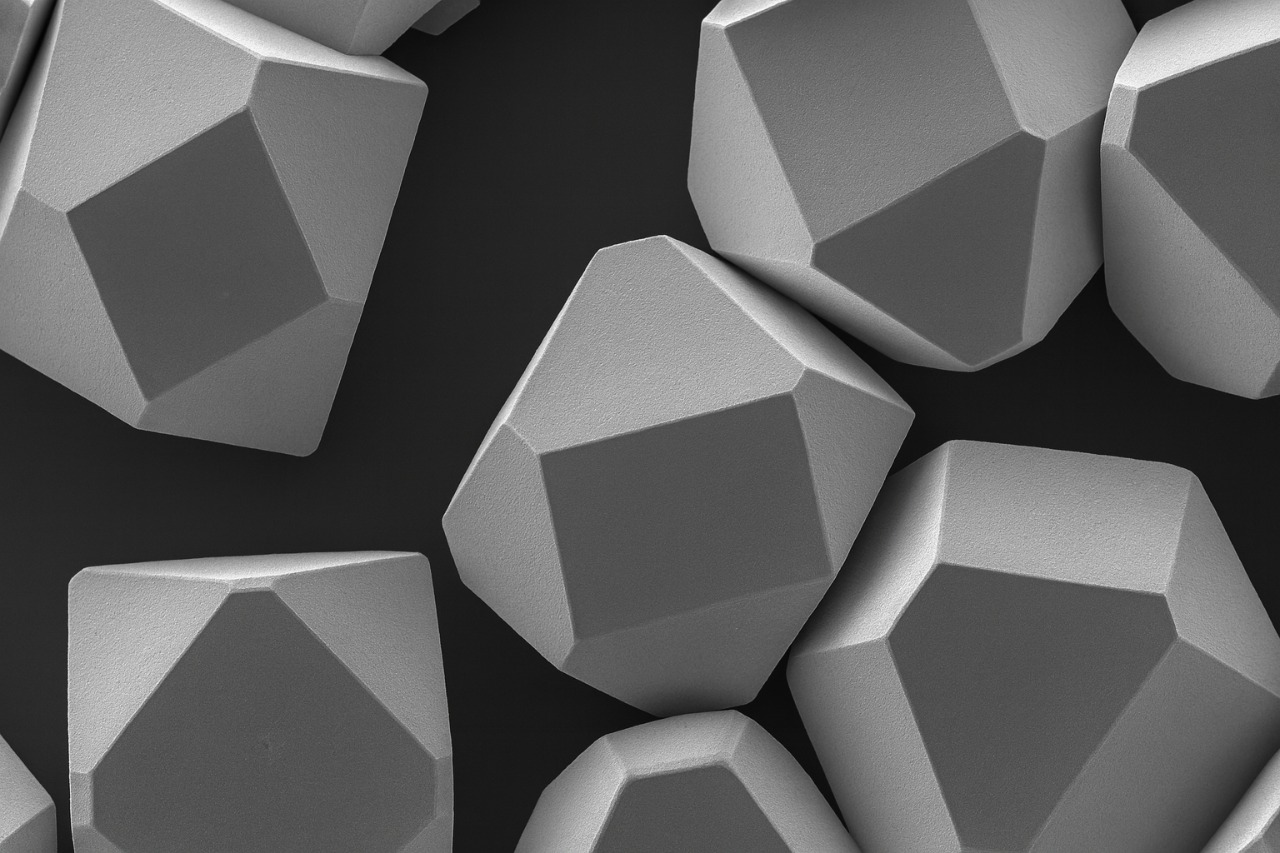

1. Initial Contact and Tool Rotation
The process begins with the diamond tool, a sophisticated cutting or grinding instrument where diamond crystals are meticulously embedded within a bond matrix. This bond matrix can be composed of various materials, including metal alloys, resin compounds, or ceramic-based substances, each chosen for their ability to hold the diamonds securely while facilitating the cutting process.
As the tool rotates, it draws energy from the machine motor, converting this mechanical energy into kinetic energy that propels the tool’s rotation.

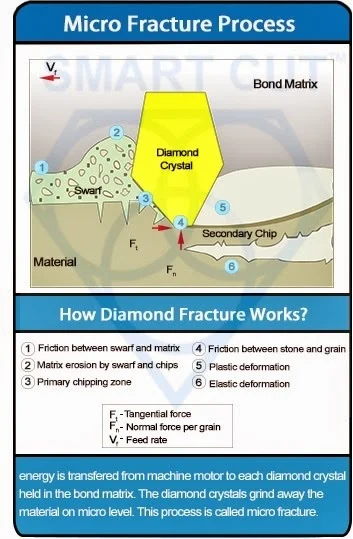
This rotational motion is crucial as it generates the necessary force for the cutting or grinding action. The speed and torque of the rotation are meticulously controlled to optimize the tool’s performance, ensuring that it can efficiently cut through even the hardest materials.
The diamond particles within the bond matrix act as the primary cutting elements. These particles, known for their extreme hardness and sharpness, are strategically positioned so that their cutting edges are exposed at the surface of the bond matrix. As the tool rotates, these exposed diamond edges come into contact with the material being processed.
During this contact, the diamond particles engage with the material through a combination of abrasion and pressure. Abrasion occurs as the hardness of the diamond particles allows them to scratch and wear away the material’s surface. This abrasive action is highly effective, given that diamonds are one of the hardest known materials, capable of cutting through a wide range of substances, including metals, ceramics, and composites.


Understanding the Micro Fracture Process in Diamond Tools
The illustration depicts the micro fracture process, a critical mechanism by which diamond tools maintain their cutting efficiency. This process begins with energy transfer from the machine motor to the diamond crystals embedded in the bond matrix. As the tool rotates, the diamond crystals grind away the material on a micro level, a phenomenon known as micro fracturing.
The process involves several key interactions:
-
 Friction Between Swarf and Matrix: As the diamond cuts, friction is generated between the swarf (debris) and the bond matrix.
Friction Between Swarf and Matrix: As the diamond cuts, friction is generated between the swarf (debris) and the bond matrix.
-
 Matrix Erosion: The bond matrix erodes due to the abrasive action of the swarf and chips, gradually exposing new diamond particles.
Matrix Erosion: The bond matrix erodes due to the abrasive action of the swarf and chips, gradually exposing new diamond particles.
-
 Primary Chipping Zone: The diamond crystal creates a primary chipping zone, removing material in small chips.
Primary Chipping Zone: The diamond crystal creates a primary chipping zone, removing material in small chips.
-
 Friction Between Stone and Grain: There is also friction between the diamond particles and the material grains, contributing to the cutting action.
Friction Between Stone and Grain: There is also friction between the diamond particles and the material grains, contributing to the cutting action.
-
 Plastic Deformation: The material undergoes plastic deformation, bending and shaping under the pressure of the diamond crystal.
Plastic Deformation: The material undergoes plastic deformation, bending and shaping under the pressure of the diamond crystal.
-
 Elastic Deformation: Elastic deformation occurs as the material temporarily deforms before fracturing.
Elastic Deformation: Elastic deformation occurs as the material temporarily deforms before fracturing.
These interactions collectively facilitate the continuous exposure of fresh, sharp diamond edges, ensuring sustained cutting efficiency and tool longevity. The normal force (Fₙ) per grain and the tangential force (Fₜ) are critical in maintaining the effectiveness of this process, with the feed rate (Vₓ) determining the speed at which material is removed. This intricate balance of forces and material interactions highlights the advanced engineering behind diamond tools, making them indispensable for precision cutting and grinding applications.
Cutting / Grinding Mechanism
Initial Contact:
When the diamond tool is brought into contact with the material, the diamond crystals on the leading edge of the blade or grinding surface penetrate the material. This initial contact is marked by the application of force, directed perpendicularly to the material’s surface. The material holding method or fixture plays a crucial role in keeping the workpiece stable and secure, facilitating precise and controlled cutting or grinding.

Cutting Action:
As the tool rotates or moves, the diamond crystals slide or roll over the material’s surface. The extreme hardness of diamonds enables them to effectively abrade the material’s surface. This significant hardness difference between the diamond particles and the material allows the diamonds to scratch and cut into the material, forming grooves or channels as they move. Each diamond particle acts as a miniature cutting point, removing small fragments of the material with each pass. This process is especially effective for materials that are too hard or brittle for conventional cutting tools.
Grinding Action:
In addition to cutting, the diamonds also perform a grinding action, gradually wearing down the material's surface. The grinding mechanism involves the diamond particles applying consistent pressure against the material, leading to the removal of tiny material particles and smoothing the surface. This grinding process can be adjusted by varying the tool's speed and pressure, allowing for precise control over the surface finish and the rate of material removal. Simultaneously, the tool exerts pressure on the material, which, combined with the abrasive action, creates grooves in the material’s surface.
The Role of Abrasion in Diamond Tool Performance
Abrasion is a fundamental aspect of diamond tool operation, driven by the significant hardness disparity between diamonds and the materials they cut. As the diamond particles scratch and grind against the workpiece, they gradually wear down the surface, creating an effective cutting action. The provided illustrations offer a detailed insight into the abrasion mechanism and the wear dynamics of diamond tools, crucial for understanding their cutting efficiency.
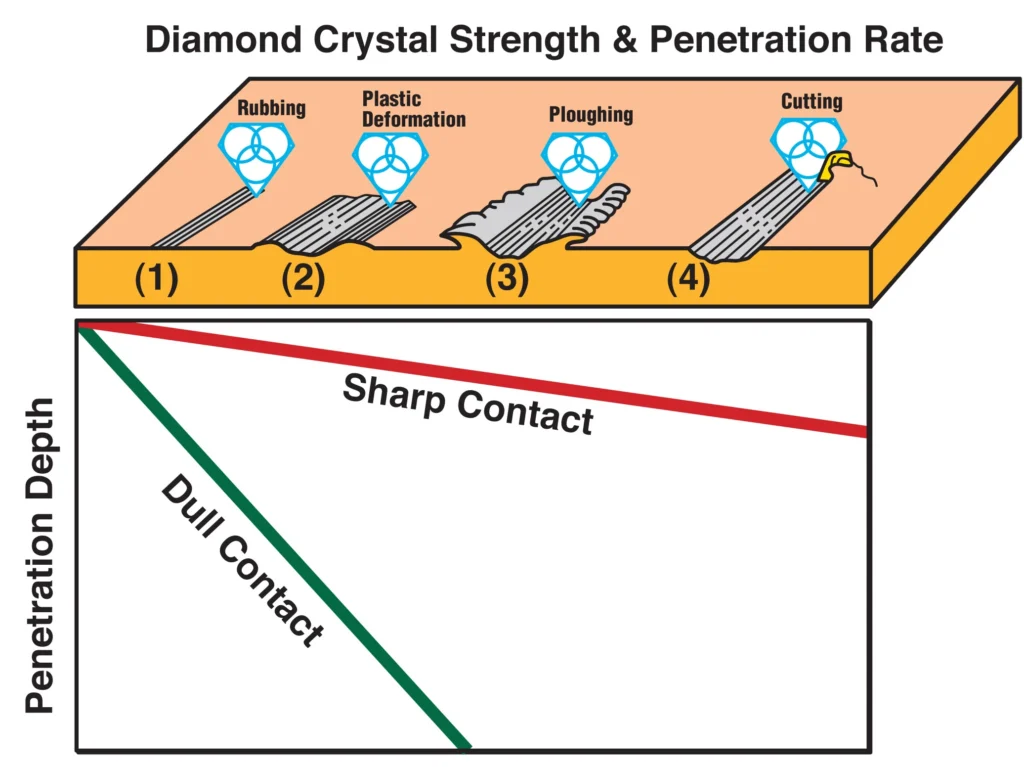
-
 Rubbing: Initially, the diamond crystal comes into contact with the material, creating friction as it starts to engage.
Rubbing: Initially, the diamond crystal comes into contact with the material, creating friction as it starts to engage.
-
 Plastic Deformation: As pressure increases, the material undergoes plastic deformation, where it begins to bend and yield to the diamond’s force.
Plastic Deformation: As pressure increases, the material undergoes plastic deformation, where it begins to bend and yield to the diamond’s force.
-
 Ploughing: The diamond starts to plough through the material, pushing it aside and forming grooves.
Ploughing: The diamond starts to plough through the material, pushing it aside and forming grooves.
-
 Cutting: Finally, the diamond crystal cuts into the material, removing chips and debris, effectively shaping or grinding the surface.
Cutting: Finally, the diamond crystal cuts into the material, removing chips and debris, effectively shaping or grinding the surface.
The penetration depth of the diamond is influenced by its sharpness. Sharp contacts result in deeper penetration, while dull contacts reduce the cutting efficiency, highlighting the importance of maintaining sharp diamond edges for optimal performance.
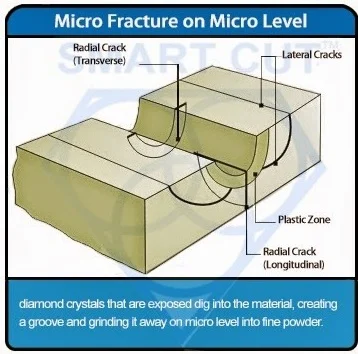
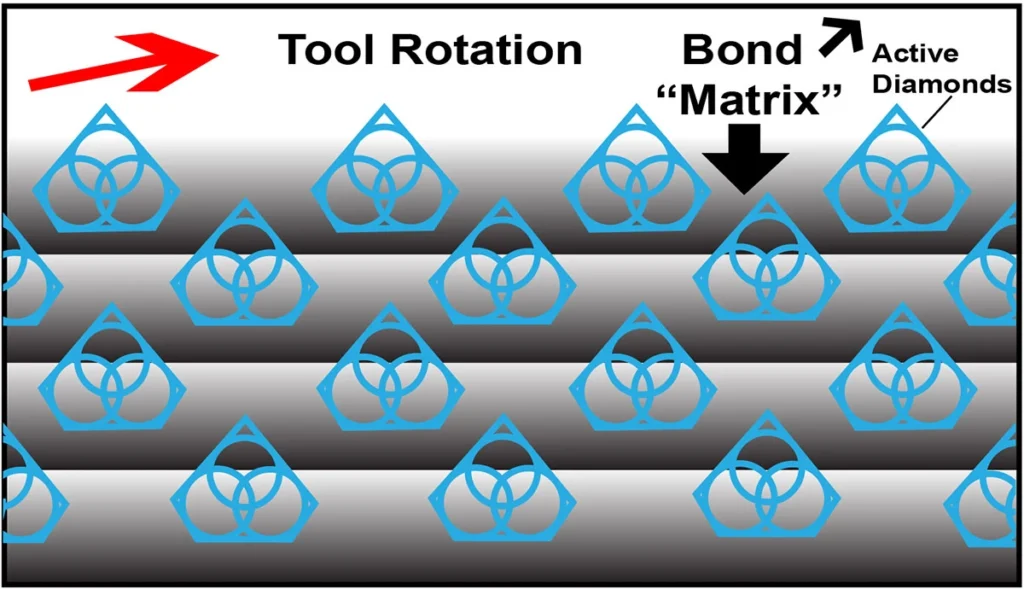
These grooves are essentially channels where material is removed, and their formation is a key aspect of the cutting or grinding process. The interaction between the rotating diamond particles and the material results in the chipping away of small particles from the material’s surface, effectively shaping or refining it as desired.
The bond matrix plays a pivotal role in this process. It serves as the medium that holds the diamond particles in place, ensuring they remain stable and effective during operation. The strength and composition of the bond matrix are critical, as they must withstand the mechanical stresses of rotation and the abrasive forces of cutting, all while gradually exposing new diamond edges as the outer particles wear down. This continuous exposure of fresh diamond edges is essential for maintaining the tool’s cutting efficiency and extending its operational life.
Furthermore, the design and formulation of the bond matrix are tailored to specific applications. For instance, a metal bond matrix may be chosen for its durability and heat resistance, making it suitable for heavy-duty cutting tasks. In contrast, a resin bond matrix might be selected for its flexibility and ability to produce smoother finishes, ideal for precision grinding applications.
2. Exposed Diamond Action
Following the initial contact and material removal, the diamond tool enters a critical phase where the previously embedded diamonds become exposed. This exposure occurs as the outermost layer of the bond matrix wears away during the cutting or grinding process. As these diamond particles emerge, they take on the primary role in continuing the material removal.
The exposed diamonds are subjected to intense mechanical forces due to the tool’s rotation and the hardness of the material being processed. These forces cause the diamonds to undergo microscopic fracturing or cracking.

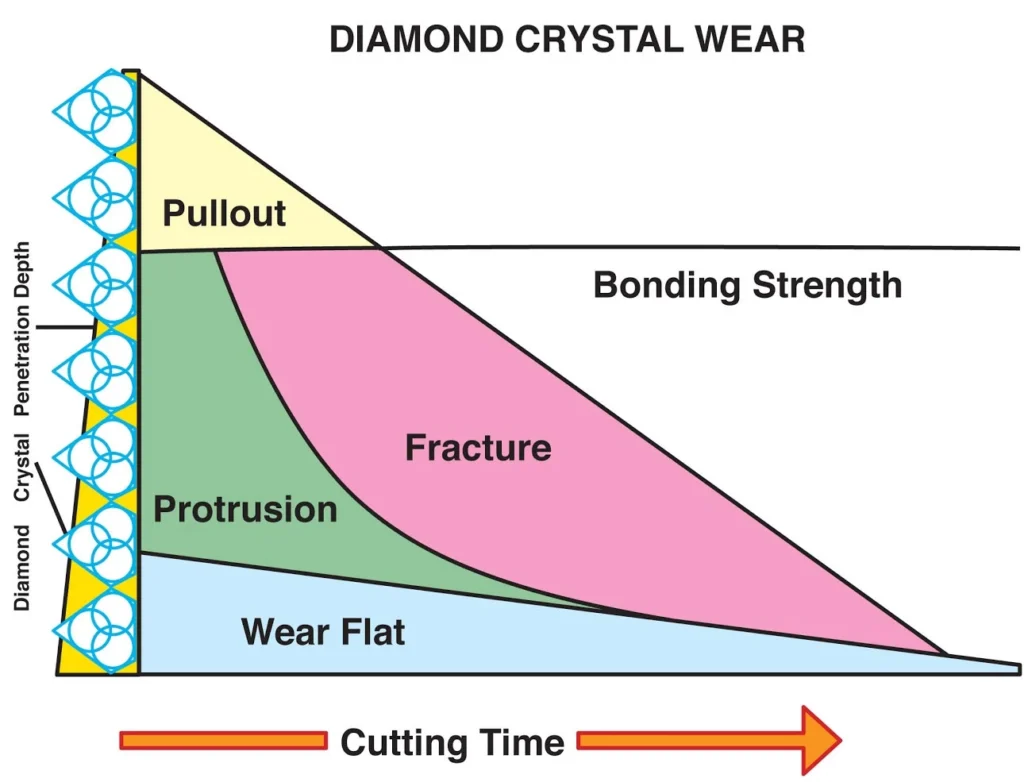
Diamond Crystal Wear
The wear process of diamond crystals over time is a crucial aspect of how diamond tools maintain their cutting efficiency. This illustration provides a detailed view of this wear process, highlighting the various stages the diamond particles undergo as they engage with the material.
Protrusion: Initially, the diamond particles are prominently protruding from the bond matrix. In this stage, the diamonds are fully exposed and actively engage with the material. The sharp edges of the diamond crystals cut into the material, efficiently removing small particles and initiating the primary cutting or grinding action. This stage is characterized by maximum cutting efficiency as the diamond edges are sharp and fully exposed, making direct contact with the material.
The wear process of diamond crystals over time is a crucial aspect of how diamond tools maintain their cutting efficiency. This illustration provides a detailed view of this wear process, highlighting the various stages the diamond particles undergo as they engage with the material.
Protrusion: Initially, the diamond particles are prominently protruding from the bond matrix. In this stage, the diamonds are fully exposed and actively engage with the material. The sharp edges of the diamond crystals cut into the material, efficiently removing small particles and initiating the primary cutting or grinding action. This stage is characterized by maximum cutting efficiency as the diamond edges are sharp and fully exposed, making direct contact with the material.
Wear Flat: As the cutting process continues, the abrasive interaction between the diamond particles and the material causes the diamonds to wear down. This wear leads to the flattening of the diamond surfaces, known as wear flat. During this phase, the sharp edges of the diamonds are reduced, and the cutting efficiency begins to decline. The flattening effect is a result of continuous friction and pressure, which gradually erodes the diamond’s surface, making it less effective at penetrating and cutting the material.
Fracture: Under continuous stress and operational forces, the diamond particles undergo fracturing. This stage is critical as it renews the cutting capability of the diamond tool. The fractures occur due to the inherent brittleness of diamonds and the high stresses they encounter during cutting. When diamonds fracture, new, sharp edges are exposed, effectively renewing the tool’s cutting action. This self-renewing characteristic of diamonds is essential for maintaining consistent cutting performance over time, as it prevents the tool from becoming dull and ineffective.
Pullout: Eventually, the worn or fractured diamond particles are pulled out from the bond matrix. This stage occurs when the bond holding the diamond particles weakens due to continuous erosion and wear. As the bond matrix wears away, it loses its grip on the diamond particles, leading to their pullout. This process is beneficial as it clears the way for fresh, sharp diamonds to be exposed from within the matrix. The continuous exposure of new diamond particles ensures that the tool maintains its cutting efficiency, even as older diamonds are worn away or fractured.
This phenomenon, known as controlled fracturing, is a deliberate and beneficial aspect of diamond tool operation.
The fracturing process breaks the diamonds into smaller fragments, each with new, sharp cutting edges. These fresh edges enhance the tool’s ability to cut or grind the material efficiently, maintaining a high level of performance throughout the tool’s lifespan.


The effectiveness of this fracturing process is largely attributed to the intrinsic properties of diamonds. Diamonds are the hardest known natural material, which allows them to cut through other hard substances with ease. Find out more on why use diamond or cbn>>
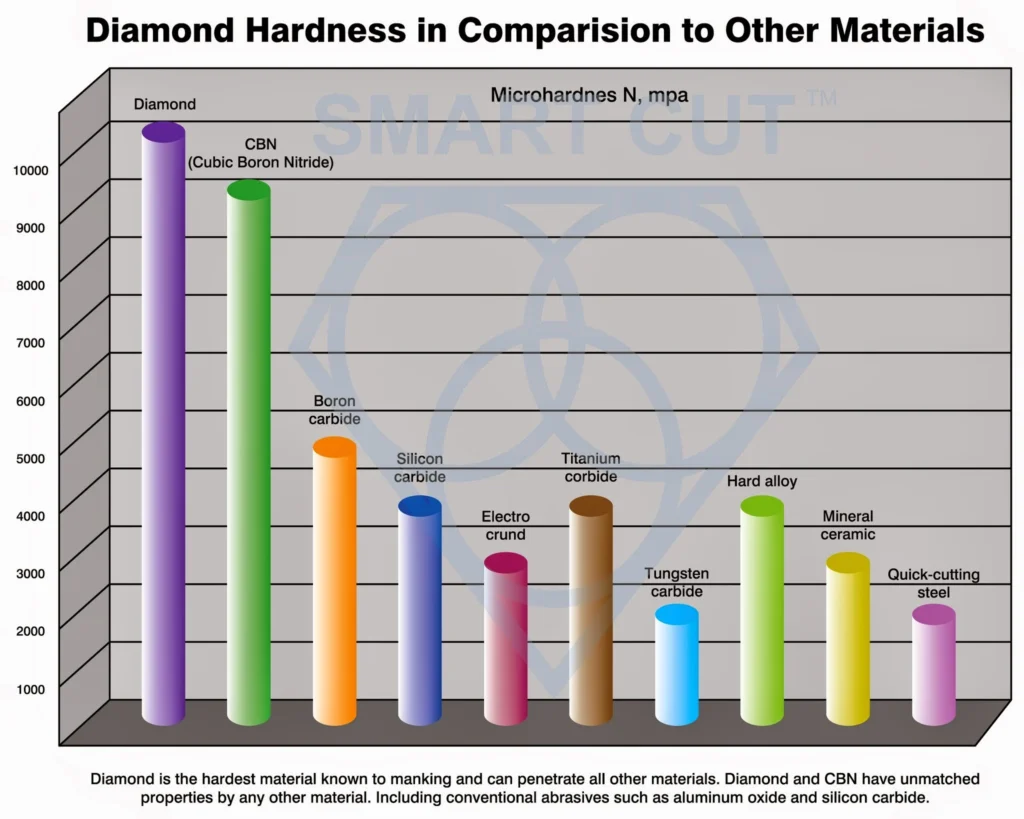
Their crystalline structure enables them to fracture in a controlled manner, rather than wearing down smoothly. This unique property ensures that diamond tools consistently expose new cutting edges, thereby sustaining their cutting or grinding efficiency.
Find out more about diamond & cbn crystal shapes and how they affect cutting performance >>>
The speed at which the tool rotates is a crucial factor in this stage. Higher rotation speeds increase the kinetic energy transferred to the diamonds, enhancing their cutting capability. However, the speed must be carefully regulated to balance cutting efficiency with tool longevity. Excessive speeds can accelerate wear and potentially damage the bond matrix, while insufficient speeds may reduce cutting effectiveness.
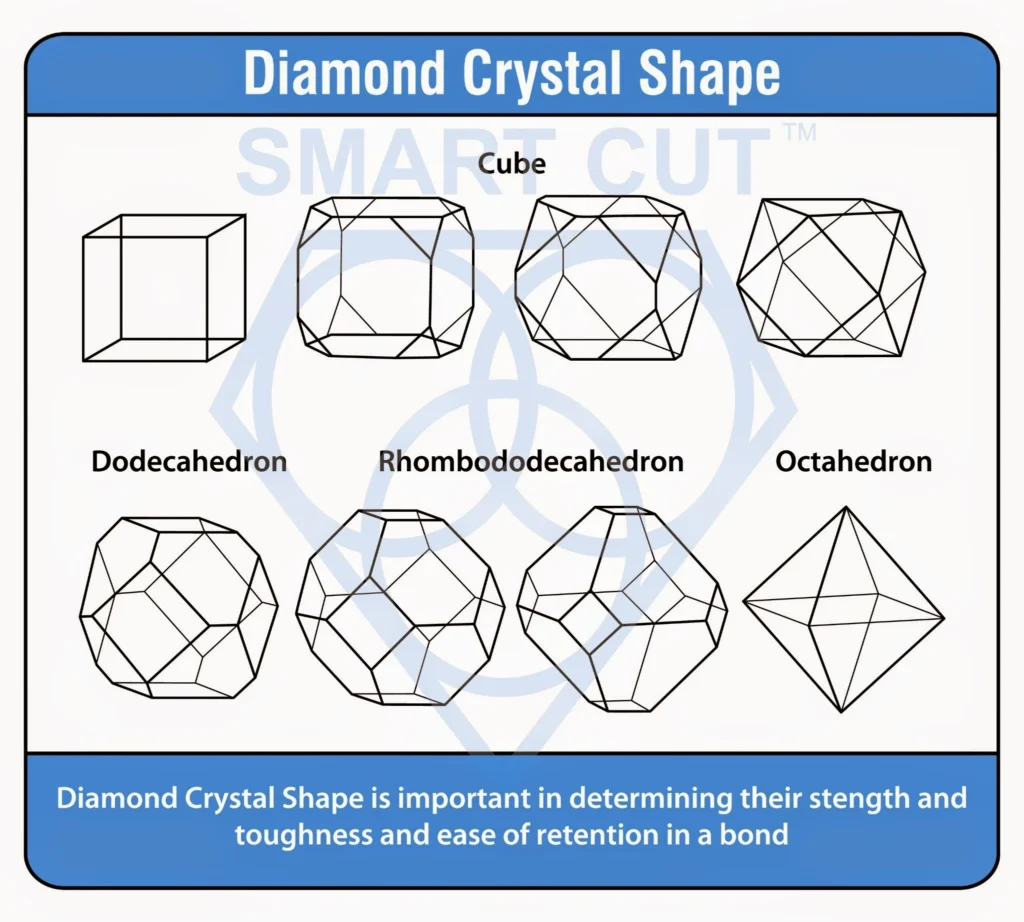
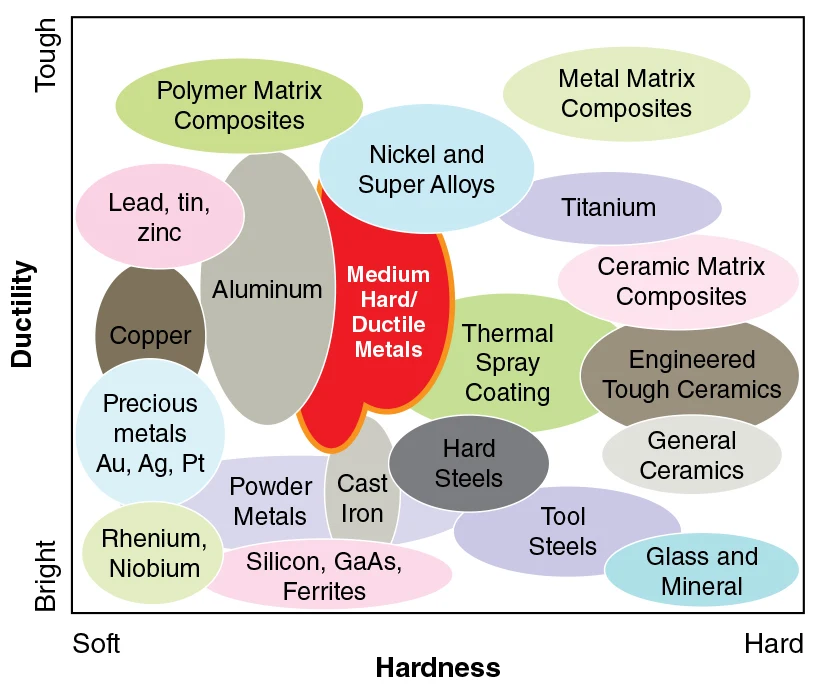
Several factors influence the rate of wear and fracturing of the diamond particles:
-
 Material Hardness: Initially, the diamond crystal comes into contact with the material, creating friction as it starts to engage.
Material Hardness: Initially, the diamond crystal comes into contact with the material, creating friction as it starts to engage.
-
 Coating:Materials with coatings, such as protective layers or surface treatments, can affect the cutting process. Coatings may introduce additional resistance or cause variations in friction, influencing how the diamonds interact with the material.
Coating:Materials with coatings, such as protective layers or surface treatments, can affect the cutting process. Coatings may introduce additional resistance or cause variations in friction, influencing how the diamonds interact with the material.
-
 Composition: The chemical and physical composition of the material also impacts the tool’s performance. Materials with varying densities, toughness, and thermal properties can alter the dynamics of the cutting process, affecting the rate of diamond wear and fracturing.
Composition: The chemical and physical composition of the material also impacts the tool’s performance. Materials with varying densities, toughness, and thermal properties can alter the dynamics of the cutting process, affecting the rate of diamond wear and fracturing.
3. Wear of Bond Matrix
In the continued operation of diamond tools, the bond matrix that holds the diamond particles in place gradually begins to wear away. This phase is critical to the tool's functionality and efficiency, as it directly impacts the exposure of new diamond particles necessary for sustained cutting performance.
The wear of the bond matrix occurs as a result of the continuous friction and pressure exerted during the cutting or grinding process. As the tool rotates, these forces act upon the bond matrix, leading to its gradual erosion. This erosion is not merely a byproduct of the tool's operation but a carefully designed feature that facilitates the continuous renewal of the tool’s cutting edges.

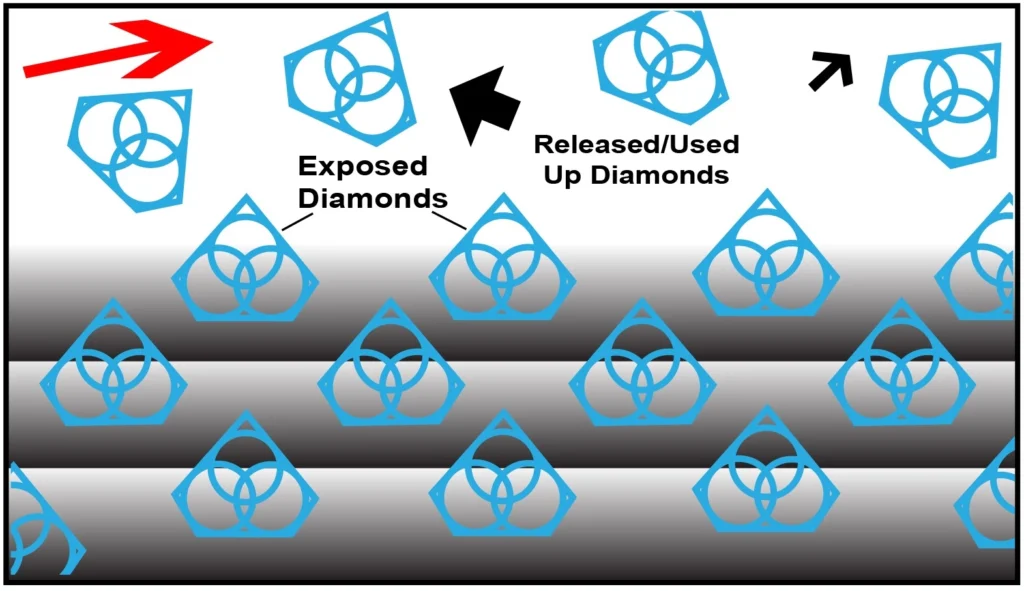
The bond matrix is engineered to wear at a controlled rate that complements the wear rate of the diamond particles. This synchronization is crucial for maintaining optimal cutting efficiency. As the matrix wears down, it releases the embedded diamond particles that have become dull or fully consumed due to the intense cutting action. The removal of these worn-out particles is essential to prevent clogging and to ensure that the tool maintains its cutting effectiveness.
As the matrix wears away, new, sharp diamond particles are exposed. These fresh diamonds take over the cutting action, ensuring that the tool continues to operate at peak efficiency. This process of constant renewal allows diamond tools to maintain a sharp cutting edge throughout their operational life, which is particularly important for applications requiring high precision and consistency.
The design and composition of the bond matrix are tailored to balance durability with the need for continuous exposure of new diamonds. Various types of bond matrices, including metal, resin, and vitrified bonds, offer different wear characteristics suited to specific applications (Find out more about comparing different diamond & cbn bond technologies>>>):
Metal Bond Matrix: Known for its durability and strength, the metal bond matrix is typically used in heavy-duty cutting and grinding applications. Its slower wear rate is ideal for tasks requiring long-lasting performance and effective heat dissipation. Find out more about sintered (metal bond) diamond & cbn tools >>>
Resin Bond Matrix: This matrix offers more flexibility and is often used for applications requiring a finer finish. The resin bond matrix tends to wear more quickly than metal bonds, which is advantageous for exposing new diamonds rapidly in precision grinding tasks. Find out more about resin bond diamond & cbn tools >>>
Electroplated Bond Tools: Electroplated bond tools feature a single layer of diamond or CBN particles attached to the tool's surface using a nickel plating. This method provides a high concentration of abrasive particles, leading to aggressive cutting action. These tools are ideal for applications requiring high precision and can be used on a variety of materials, including composites, ceramics, and hardened steels. Electroplated tools are also known for their ability to maintain a consistent profile, making them suitable for intricate shapes and profiles. Find out more about electroplated diamond & CBN tools >>
Brazed Bond Tools: Brazed bond tools utilize a single layer of diamond or CBN particles that are brazed onto the tool's surface. This bonding method offers excellent adhesion and allows for a higher exposure of abrasive particles, leading to enhanced cutting performance. Brazed tools are particularly effective in applications requiring high material removal rates and are commonly used in stone, concrete, and composite material processing. Their robust construction also provides superior durability in demanding conditions. Find out more about brazed diamond & CBN tools >>
Vitrified Bond Matrix: Featuring a ceramic composition, the vitrified bond matrix provides excellent strength and precision. It is designed to wear at a rate that ensures a continuous supply of sharp diamonds, making it suitable for high-stress applications requiring meticulous material removal. Find out more about vitrified bond diamond & cbn tools >>>
Several factors influence the wear rate of the bond matrix:
Cutting Conditions: The speed and force of the tool’s rotation, along with the nature of the material being cut, play significant roles in the wear rate. Higher speeds and harder materials typically accelerate matrix erosion.
Matrix Composition: The specific materials and compounds used in the bond matrix determine its hardness, toughness, and wear characteristics, all of which influence how quickly it erodes during use.
Operational Environment: Factors such as temperature, humidity, and exposure to abrasive particles can impact the wear rate of the bond matrix, affecting its performance and longevity.
Environmental Conditions
Environmental conditions play a significant role in the performance and longevity of diamond tools. Factors such as temperature, humidity, and the presence of coolants or lubricants can substantially influence the tool's operational efficiency and durability.
Temperature: High temperatures are a critical consideration when using diamond tools. During cutting or grinding operations, significant heat can be generated due to the friction between the diamond particles and the material being processed. This heat buildup can have several impacts:
Thermal Stress on Diamonds: Excessive temperatures can cause thermal stress on the diamond particles. Diamonds, while extremely hard, are also brittle and can fracture under high thermal stress. This fracturing, while sometimes beneficial for exposing new cutting edges, can also lead to premature wear and loss of diamond particles, reducing the tool's effectiveness.
Diamond Crystal Wear Mechanism
Diamond Crystal Wear Mechanism, depicts the various modes of diamond wear and loss as a function of diamond strength. It highlights three primary mechanisms: Smashing, Microchipping, and Pullout, each influencing the durability and effectiveness of diamond tools.
Smashing - occurs when diamond crystals with lower strength encounter high-impact forces during cutting or grinding. These forces cause the diamonds to break or shatter into larger fragments. Smashing leads to significant diamond loss and can reduce the cutting efficiency of the tool. This mode of wear is common in applications where the material being processed is extremely hard, causing brittle diamonds to fracture easily under pressure.
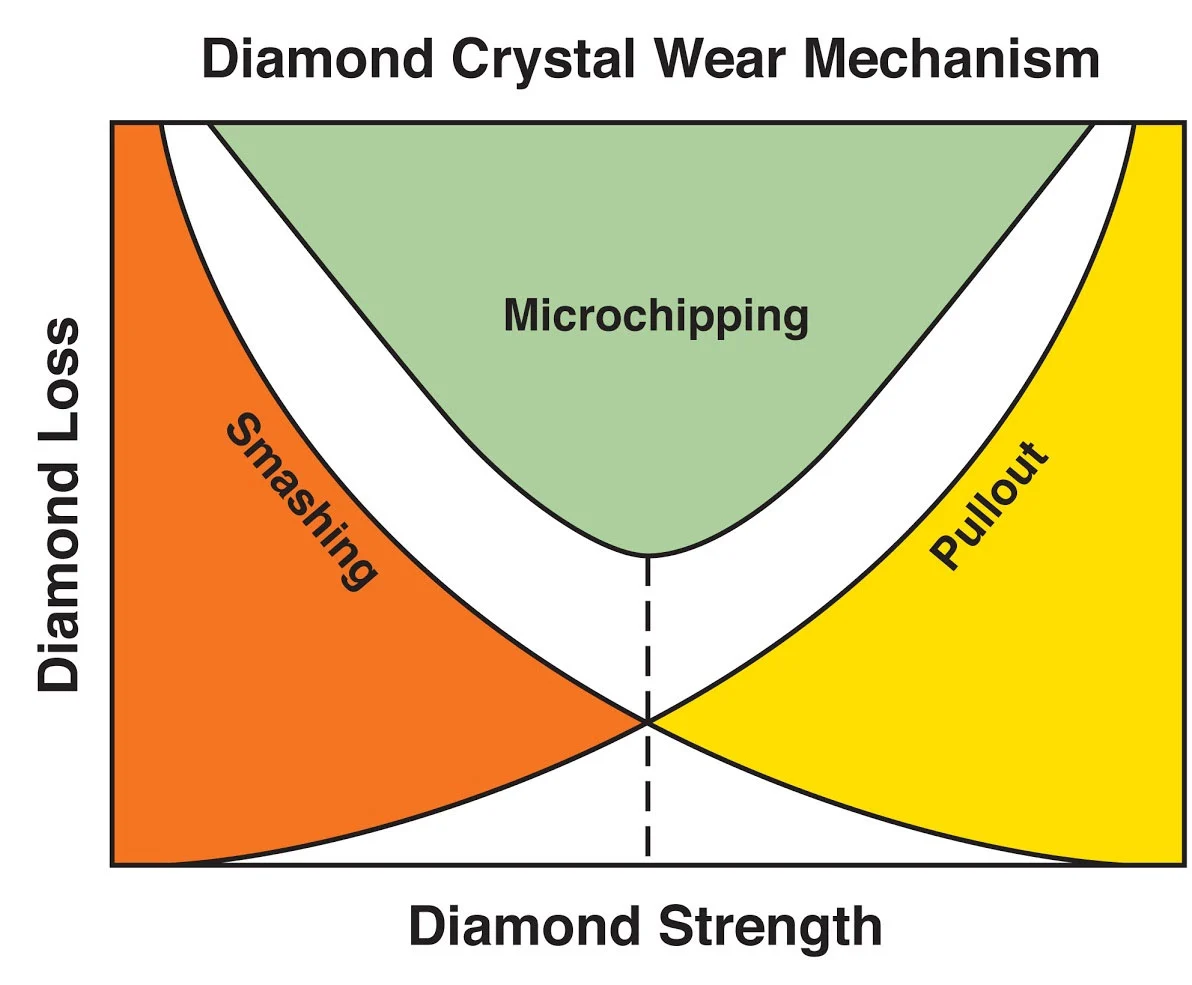
Microchipping - involves the formation of small chips or fractures on the diamond surface. This occurs when diamonds with moderate strength are subjected to continuous abrasive forces. Microchipping is generally desirable as it exposes new, sharp cutting edges without causing excessive diamond loss. It maintains the tool’s cutting efficiency by constantly renewing the diamond surface. This mode of wear is optimal for maintaining a balance between tool durability and cutting performance.
Pullout - occurs when diamond crystals with high strength are dislodged from the bond matrix due to wear or weakening of the bond. Despite the diamonds being intact, they are removed from the tool as the bond erodes or loses its grip. Pullout leads to the loss of functional diamonds, reducing the tool’s cutting efficiency. It is more likely in applications where the bond matrix wears away faster than the diamond itself, causing even strong diamonds to be ejected from the tool.
Find out more how diamond hardness affects diamond tools >>>
Degradation of Bond Matrix: The bond matrix, which holds the diamonds in place, can also be adversely affected by high temperatures. Metal bond matrices may soften or deform, while resin bond matrices can degrade or melt, and vitrified bond matrices might experience thermal expansion or cracking. These changes can weaken the bond, leading to a loss of diamonds and reduced tool performance.
To mitigate these thermal effects, it is essential to manage the operating temperature effectively. This is typically achieved through the use of coolants or lubricants.
Coolants and Lubricants: Coolants and lubricants are essential in managing the heat generated during cutting or grinding processes. They serve several crucial functions:
Heat Dissipation: Coolants, often in the form of water or specialized cutting fluids, help to dissipate heat away from the cutting zone. By absorbing and carrying away heat, coolants prevent excessive temperature buildup, reducing thermal stress on both the diamonds and the bond matrix.
Friction Reduction: Lubricants, which can be oil-based or synthetic, reduce friction between the diamond particles and the material. This reduction in friction not only minimizes heat generation but also decreases the wear rate of the diamonds and bond matrix, prolonging the tool's life.
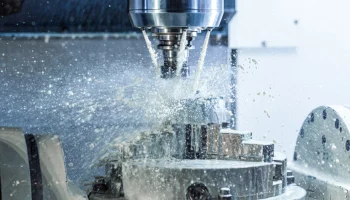
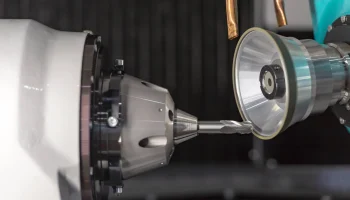
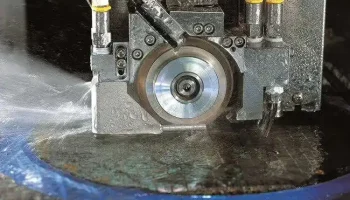
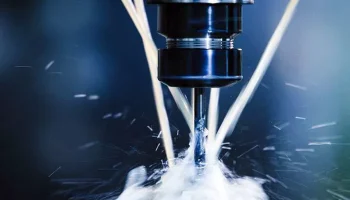
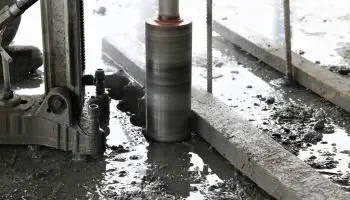
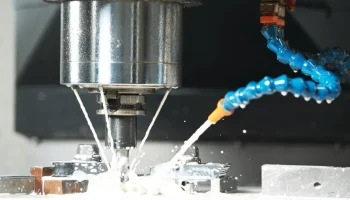
Material Removal and Chip Clearance: Coolants and lubricants aid in flushing away debris, chips, and swarf from the cutting area. This keeps the cutting zone clean, reduces clogging, and ensures a smoother cutting action, which enhances the overall efficiency and lifespan of the tool.
Find out more on Coolants used for Diamond Tools >>>
Humidity: Humidity levels can also affect diamond tool performance:
Corrosion: High humidity can lead to corrosion of the bond matrix, especially if it contains metal components. Corrosion can weaken the bond, causing premature loss of diamonds and reducing the tool's effectiveness.
Coolant Interaction: Humidity can influence the properties and effectiveness of coolants. For instance, water-based coolants can become less effective in high humidity conditions due to changes in viscosity and thermal conductivity. Proper selection and maintenance of coolants are necessary to ensure they function optimally under varying humidity levels.

As the cutting process continues, the controlled fracturing of diamonds ensures a consistent renewal of sharp edges, which is crucial for maintaining the tool's cutting efficiency. This continuous exposure of fresh diamonds is facilitated by the gradual erosion of the bond matrix, designed to release new diamond particles as the outer layers wear away.
4. Continuous Cutting Cycle
The continuous cutting cycle of diamond tools is a sophisticated process that ensures sustained cutting efficiency and prolonged tool life. This cycle is a dynamic interplay between the tool’s rotation, the wear of the bond matrix, and the exposure of fresh diamond particles, which together enable consistent and effective material removal.
As the tool rotates, the diamond particles embedded in the bond matrix remain actively engaged with the material being processed. This engagement is facilitated by the high rotational speed and the inherent hardness of the diamonds, which allows them to penetrate and abrade the material efficiently. The continuous contact between the diamonds and the material results in a steady cutting or grinding action, crucial for maintaining the tool's effectiveness over time.


The bond matrix plays a pivotal role in this process. It is designed to wear away gradually, releasing new diamond particles as the outer layers erode. This gradual erosion is essential for several reasons:
Consistent Exposure of Sharp Edges: As the bond matrix wears down, it continuously exposes fresh, sharp diamond edges. This consistent renewal of cutting edges ensures that the tool maintains a high level of cutting efficiency, reducing the likelihood of dulling and maintaining smooth operation.
Prevention of Clogging: The gradual wear of the bond matrix helps prevent the tool from clogging with material debris. By releasing new diamond particles, the tool effectively clears away chips and swarf, which might otherwise obstruct the cutting surface and diminish performance.
Optimal Use of Diamonds: The controlled erosion of the bond matrix ensures that diamond particles are utilized efficiently. The matrix is designed to wear at a rate that synchronizes with the wear rate of the diamonds, ensuring that each diamond is used to its full potential before being released from the bond. Utilizing SMART CUT technology where diamond are evenly distributed and oriented inside the bond matrix this can be done more efficiently then with conventional technologies. Find out more about SMART CUT technology>>>
The continuous cutting cycle is also influenced by several key factors:
1. Tool Design and Material Composition:
The design of the bond matrix and the type of diamonds used are tailored to specific applications, ensuring that the tool performs optimally under the intended operating conditions. The composition of the bond matrix, whether metal, resin, or vitrified, determines its wear characteristics and the rate at which new diamonds are exposed. Find out more abut different diamond & cbn bond types>>>
2. Cutting Parameters (RPM’s & Feed Rates):
The speed and feed rate at which the tool operates are critical in maintaining the cutting cycle. Proper calibration of these parameters ensures that the tool operates within optimal conditions, maximizing cutting efficiency and minimizing unnecessary wear. Find more about rpm’s for diamond & cbn tools>>>
3. Cooling and Lubrication:
The use of coolants and lubricants helps to manage heat and friction, which are byproducts of the cutting process. Effective cooling and lubrication reduce thermal stress on the diamonds and the bond matrix, extending the tool's operational life and enhancing cutting performance. Find out more about coolants and lubricants for diamond & cbn tools>>>
4. Material Properties:
The hardness, composition, and texture of the material being cut can affect the continuous cutting cycle. Harder materials may accelerate the wear of the bond matrix and diamonds, while softer materials may require adjustments in tool speed and feed rate to maintain efficient cutting. Find out more about materials machined with diamond & cbn tools>>>
Understanding Material Debris Shapes and Chipping in Diamond Tools
This illustration shows the chipping process, which is a crucial aspect of how diamond tools interact with different materials. This process complements abrasion, enhancing the tool's ability to cut through a variety of substances efficiently.

Chipping Process:
Diamonds, due to their exceptional hardness, are highly resistant to deformation. This property allows diamond tools to effectively chip away at materials during cutting or grinding. When the tool encounters a material, the interaction between the hard diamond particles and the relatively softer workpiece leads to the formation of micro-fractures or chips.
1. Interaction with Hard Materials (e.g., Ceramics):
-
 Debris Formation: When cutting hard materials such as ceramics, the diamond crystals penetrate the material's surface, creating high-stress points. The inherent brittleness of ceramics leads to the formation of sharp, angular debris as the material fractures under pressure.
Debris Formation: When cutting hard materials such as ceramics, the diamond crystals penetrate the material's surface, creating high-stress points. The inherent brittleness of ceramics leads to the formation of sharp, angular debris as the material fractures under pressure.
-
 Chipping Mechanism:The sharp edges of the diamond crystals initiate micro-fractures within the ceramic material. These fractures propagate quickly, resulting in the detachment of small, angular chips from the workpiece. The shape and size of the debris are influenced by the hardness and brittleness of the ceramic.
Chipping Mechanism:The sharp edges of the diamond crystals initiate micro-fractures within the ceramic material. These fractures propagate quickly, resulting in the detachment of small, angular chips from the workpiece. The shape and size of the debris are influenced by the hardness and brittleness of the ceramic.
-
 Expulsion of Chips: The generated chips are expelled from the cutting area, preventing clogging and ensuring a continuous cutting action. Effective removal of debris is critical to maintaining the tool's efficiency and preventing damage to the cutting surface.
Expulsion of Chips: The generated chips are expelled from the cutting area, preventing clogging and ensuring a continuous cutting action. Effective removal of debris is critical to maintaining the tool's efficiency and preventing damage to the cutting surface.
2. Interaction with Soft Materials (e.g., Copper):
-
 Debris Formation: In contrast, when cutting softer materials like copper, the diamond crystals cause the material to deform plastically before chipping occurs. This results in the formation of smoother, more rounded debris.
Debris Formation: In contrast, when cutting softer materials like copper, the diamond crystals cause the material to deform plastically before chipping occurs. This results in the formation of smoother, more rounded debris.
-
 Chipping Mechanism:The diamond particles apply pressure to the copper, which, due to its ductility, bends and stretches before small pieces break off. This chipping is less abrupt than in hard materials and produces debris with smoother edges.
Chipping Mechanism:The diamond particles apply pressure to the copper, which, due to its ductility, bends and stretches before small pieces break off. This chipping is less abrupt than in hard materials and produces debris with smoother edges.
-
 Expulsion of Chips: The chips from soft materials are also expelled from the cutting area, though their removal may be less critical compared to harder materials due to the smoother nature of the debris.
Expulsion of Chips: The chips from soft materials are also expelled from the cutting area, though their removal may be less critical compared to harder materials due to the smoother nature of the debris.
Challenges with Mixed Materials:
Cutting materials that are a mixture of both hard and soft components presents unique challenges:
Variable Debris Shapes: The differing hardness levels within the material lead to a variety of debris shapes and sizes. Harder components produce sharp, angular chips, while softer components yield smoother, rounded debris.
Tool Adjustment: The diamond tool must be capable of adjusting to these variations, ensuring effective cutting across different material zones. This may require fine-tuning of cutting parameters such as speed, pressure, and the use of coolants or lubricants.
The process concludes when the tool is entirely worn out, meaning all the diamond particles have been utilized and the bond matrix has significantly eroded. At this point, the tool’s cutting efficiency diminishes, and it must be replaced to ensure continued performance. The design of the bond matrix is crucial in this context, as it ensures that the matrix does not wear away too quickly, which could lead to premature loss of diamonds and reduced tool life.


Alexander Schneider is a senior applications engineer and leading authority in the industrial diamond tooling industry, with over 35 years of hands-on experience in the development, application, and optimization of ultra-thin and high-precision diamond blades, diamond core drills, and diamond and CBN grinding wheels. His work spans a wide range of advanced materials including ceramics, glass, composites, semiconductors, and high-performance metals.
Throughout his career, he has collaborated with leading R&D institutions, national laboratories, and high-tech manufacturing companies across Europe, North America, and Asia, providing technical expertise and tailored solutions for demanding cutting and surface preparation applications.
Mr. Schneider has played a pivotal role in advancing precision cutting, sectioning, dicing, and grinding technologies used in research, production, and failure analysis. He is widely respected for his ability to optimize tool design and cutting parameters to meet exacting industry standards—balancing factors such as cut quality, blade life, material integrity, and process consistency.
As an author, Mr. Schneider is known for delivering practical, application-focused insights that translate complex technical challenges into clear, actionable strategies. His articles and technical guides serve as trusted resources for engineers, researchers, and manufacturers seeking to improve precision, reduce process variability, and enhance tool performance in critical applications.

ARE YOU USING RIGHT TOOLS
FOR YOUR APPLICATION?
LET US
HELP YOU
HAVING ISSUES WITH
YOUR CURRENT TOOLS?
Knowledge Center
Diamond Tool Coolants Why, How, When & Where to Use
Selecting the Right Coolant Method for your Diamond & CBN Tools
How to Selecting Right Diamond Tools for your application
How to properly use Diamond Tools
Why use diamond
Diamond vs CBN (cubic boron nitride) Tools
What is Diamond Mesh Size and how to select best one for your application
What is Diamond Concentration and which to use for your application
Choosing The Correct Diamond Bond Type

Alexander Schneider is a senior applications engineer and leading authority in the industrial diamond tooling industry, with over 35 years of hands-on experience in the development, application, and optimization of ultra-thin and high-precision diamond blades, diamond core drills, and diamond and CBN grinding wheels. His work spans a wide range of advanced materials including ceramics, glass, composites, semiconductors, and high-performance metals.
Throughout his career, he has collaborated with leading R&D institutions, national laboratories, and high-tech manufacturing companies across Europe, North America, and Asia, providing technical expertise and tailored solutions for demanding cutting and surface preparation applications.
Mr. Schneider has played a pivotal role in advancing precision cutting, sectioning, dicing, and grinding technologies used in research, production, and failure analysis. He is widely respected for his ability to optimize tool design and cutting parameters to meet exacting industry standards—balancing factors such as cut quality, blade life, material integrity, and process consistency.
As an author, Mr. Schneider is known for delivering practical, application-focused insights that translate complex technical challenges into clear, actionable strategies. His articles and technical guides serve as trusted resources for engineers, researchers, and manufacturers seeking to improve precision, reduce process variability, and enhance tool performance in critical applications.


























































